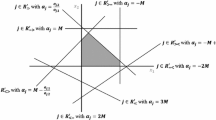Abstract
In this paper, an algorithm is presented for the transshipment problem that is an adaption of the method used by Jones, Saigal, and Schneider for solving singlecommodity, spatial-equilibrium problems. The approach uses a variable-dimension strategy in which a sequence of subproblems is formed by solving the problem ‘one-node-at-a-time’. The algorithm is tested on uncapacitated transportation problems. Although the computational results are not directly comparable to other methods (since the algorithm is implemented in C under UNIX), the results show that the method is very effective and may be competitive with the best available algorithms for linear network problems.
Similar content being viewed by others
References
H.A. Aashtiani and T.L. Magnanti, Implementing primal-dual network flow algorithms, Operations Research Center Report 055-76, M.I.T., Cambridge, Massachusetts (1976).
D.P. Bertsekas, private communication (1985).
D.P. Bertsekas, A unified framework for primal-dual methods in minimum-cost networkflow problems, Laboratory for Information and Decision Systems, M.I.T., Cambridge, Massachusetts (1984).
D.P. Bertsekas and P. Tseng, Relaxation methods for minimum-cost network-flow problems, Laboratory for Information and Decision Systems, M.I.T., Cambridge, Massachusetts (1983).
R.W. Cottle and G.B. Dantzig, Complementary pivoting theory of mathematical programming, linear algebra and its applications (1968) 103.
J. Edmonds and R.M. Karp, Theoretical improvements in algorithmic efficiency for network flow problems, Journal of the Association for Computing Machinery 19, 2(1972)248.
M.D. Grigoriadis, Algorithms for minimum cost single and multi-commodity network flow problems, Notes for Summer School in Combinatorial Optimization SOGESTA, Urbino, Italy (1978).
R. Helgason and J. Kennington,Algorithms for Network Programming (Wiley, New York, 1980).
P.C. Jones, R. Saigal and M.H. Schneider, A variable-dimension homotopy on networks for computing linear spatial equilibria, Discrete Appl. Math., to appear.
D. Klingman, A. Napier and J. Stutz, NETGEN: A program for generating large-scale capacitated assignment, transportation, and minimum cost flow network problems, Management Science 20, 5(1974)814.
J.B. Orlin, Genuinely polynomial simplex and non-simplex algorithms for the minimum cost flow problem, Sloan Working Paper No. 1615-84, M.I.T., Cambridge, Massachusetts (1984).
M.H. Schneider,Single-Commodity Spatial-Equilibria: A Network Complementarity Approach, Ph.D. Diss., Department of Industrial Engineering and Management Sciences, Northwestern University, Evanston, Illinois (1984).
R.E. Tarjan,Data Structures and Network Algorithms, Society for Industrial and Applied Mathematics, Philadelphia (1983).
Author information
Authors and Affiliations
Additional information
This research was supported, in part, by grant number ECS-8504195 from the National Science Foundation.
Rights and permissions
About this article
Cite this article
Schneider, M.H. A complementary pivoting algorithm for linear network problems. Ann Oper Res 5, 439–462 (1986). https://doi.org/10.1007/BF02739233
Issue Date:
DOI: https://doi.org/10.1007/BF02739233




